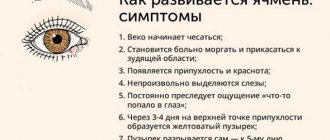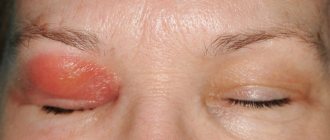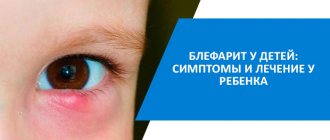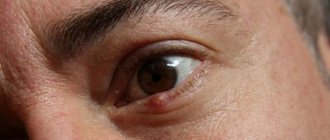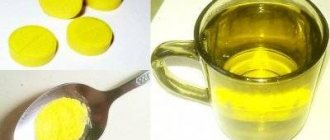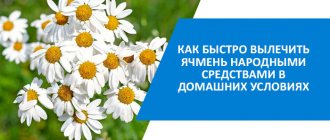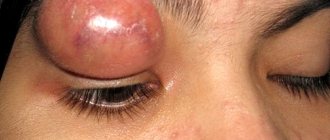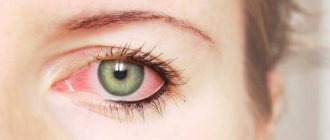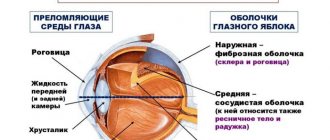Barley
This definition hides an inflammatory process that develops on the inner or outer eyelid. Barley never “warns” of its appearance and always appears suddenly. The anomaly is diagnosed in both children and adults.
In appearance, the pathology resembles a reddish compaction, which causes discomfort and pain. Most often, the disease is found in children because their immune system is not strong enough. The disease is not contagious and cannot be transmitted from a sick person to a healthy one. The duration of recovery depends on the strength of the patient’s protective barrier and the form of the pathology.
How does stye occur?
In the skin of the eyelid, near the hair follicle of the eyelashes, there is a sebaceous gland. It constantly secretes a special secretion that lubricates the hairs. If pathogenic microorganisms penetrate the gland ducts and multiply quickly, they become blocked.
As a result of disruption of the secretion process, it begins to accumulate and pus is formed. Depending on the location of the head, where the exudate has collected, barley is divided into internal and external.
| Most often, the pathology develops only in one eye, but in some cases, simultaneous damage to the left and right eye is observed. There is a high risk of relapse of the inflammatory process. Children from seven to seventeen years old are at risk. |
What is hordeolum?
The scientific name of barley is hordeolum. This is a disease of the eyelid, which is accompanied by inflammation or suppuration of the eyelash follicle or nearby glands.
Hordeolum is divided into types according to localization: stye of the upper eyelid, lower eyelid or internal (located on the inside of the eyelid). As a rule, the focus of inflammation forms on the upper eyelid, although lesions in the area under the eye are not uncommon. Depending on the strength of the immune system and the intensity of inflammation, lesions can be single or multiple, and located on one or two eyes at once.
Causes of stye on the eye in children
You cannot become infected with it, but the disease develops at a rapid pace. There are several factors that lower the protective barrier of a fragile baby’s body.
Poor hygiene
The most popular cause of inflammation. Children often forget about basic hygiene rules, touching their organs of vision with dirty hands while playing. The main task of parents is to tell the baby that in this way he can get a “sore” in his eyes, which will become a source of discomfort and pain. Return to contents
Wearing contact lenses
The use of corrective optics often causes stye. In the process of removing and putting on lenses, the hands come into contact with the mucous membrane and favorable conditions are created for infection of the eye. In addition, children often violate the rules for storing and using optics.
Weak immunity
The main purpose of the protective barrier is to protect the baby from various pathogenic microorganisms that he encounters every day on his way. Even the slightest malfunction of the immune system leads to the fact that “pests” located on the skin instantly penetrate the body and cause a variety of inflammatory diseases.
Hypothermia
The most common reason for reducing the protective barrier. All the forces of the immune system are aimed at restoring the body, and viruses remain “unattended.”
Vitamin deficiency and lack of fresh air
A lack of useful macro- and microelements and a passive lifestyle become the reasons for the appearance of barley. Junk food, lack of oxygen - all this negatively affects the functioning of the immune system and reduces its protective functions.
Diseases
Often, inflammation of the eyelash follicles is observed in babies suffering from diabetes and stomach problems. Any illness negatively affects the immune system; the body cannot give a worthy rebuff to viruses and bacteria.
Hormonal changes in the body
Puberty of a teenager leads to changes in the functioning of the endocrine system, which provokes a failure in the process of secretion production. It becomes a viscous consistency, as a result the ducts become clogged and inflammatory processes such as barley develop. Hormonal changes often cause acne in teenagers.
Staphylococcus aureus
If one of your relatives constantly suffers from barley, then the child automatically falls into the risk group. The reason lies in the fact that the entire family becomes the carrier of the disease - Staphylococcus aureus. In such situations, it is very difficult to cure the pathology, because The “pest” is resistant to most antibiotics.
Causes of internal stye or inflammation of the eyelid
diagram comparing a healthy eye with internal stye
The reasons for the development of inflammation inside the eyelid may be the following:
- dirty hands;
- dust;
- using someone else's cosmetics (eye shadows, mascara);
- improper wearing of contact lenses;
- diabetes;
- problems with hormones;
- acrid smoke;
- chronic diseases;
- inflammatory processes in the body;
- weakened immune system;
- poisoning of the body with toxins;
- problematic skin;
- avitaminosis;
- severe hypothermia;
- heredity.
Eye drops for conjunctivitis in children are quite effective.
Symptoms and development of the disease
The sebaceous gland, responsible for secretion, is located in the thickness of the eyelid. It is covered with eyelashes. The main purpose of the produced liquid is to lubricate the hairs and protect against the penetration of harmful microorganisms. Viruses and fungi, entering the gland duct, actively develop and clog it, causing inflammation.
After some time the situation worsens. The outflow of secretions is completely disrupted, the abscess intensifies, and skin secretions cannot perform their functions. Pathologies are very easy to detect; the eyelid first swells and then turns red.
As the disease progresses, a small abscess appears near the eyelashes. If you press on it, the patient experiences pain. If the pathology proceeds without complications, after a few days the head will rupture and a purulent exudate will come out of it. Children often rub their eyes, so a rupture may occur before the head matures. In this case, it is necessary to formulate the correct therapy to eliminate the risk of secondary damage and the development of complications.
| The baby begins to constantly be capricious, eats poorly, and feels a slight burning sensation in the area where the abscess forms. As a rule, full recovery takes at least seven days. Be sure to visit a doctor who will thoroughly clean the wound and eliminate the risk of infection. |
Return to contents
Anti-barley ointments for children
In a child, stye appears on the eye much more often than in an adult. This is due to a weak, undeveloped immune system and non-compliance with hygiene rules. Children often rub their eyes with their hands, which increases the risk of infections and hordeolum.
What ointment the child will be treated with and the specific dosage can only be determined by a doctor after examining the child. Under no circumstances should you prescribe medications to a child yourself, even if the adult himself is already being treated with them.
For barley in children, time-tested medications based on erythromycin and tetracycline are often prescribed. An equally popular children's remedy is Oxolinic ointment, Floxal (it can be used from the birth of the baby). They are placed behind the eyelid twice a day and only in the dosage prescribed by the doctor.
Hydrocortisone is used very rarely in children and only when other means do not help. The medicine contains hormones that can have a negative effect on a growing body (slow down growth). Only the pediatrician can decide whether this product can be applied to a baby.
What does barley look like?
External inflammation in appearance resembles a small capsule located on the edge of the eyelid. Inside the head there is purulent exudate. After the capsule breaks through, he will come out. Internal stye is difficult to detect and treatment takes longer, since the abscess forms inside the eyelid. It carries much more health hazards, because... can lead to the formation of orbital phlegmon.
Complications accompanying internal stye can cause the activation of such terrible diseases as purulent meningitis or thrombophleitis. If you notice such symptoms, contact the clinic immediately.
Symptoms
The first signs of barley in children:
- Swelling of the eyelid;
- Pain in the eye (if the stye is located inside the eyelid, there is a feeling of the presence of a foreign object under the eyelid);
- Itching in the area of inflammation;
- Redness of the eyelid;
- Sometimes your body temperature may rise;
- Inflammation of the lymph nodes closest to the lesion.
After a few days, the following symptoms appear:
- A distinct indication of the head of the stye (usually resembles a small pimple on the eyelid);
- The appearance of a yellow color at the top of the inflammation;
- Bursting of the head of the stye with the release of pus and particles of dead skin.
Sometimes a stye may disappear without breaking through. This clinical picture is quite acceptable during the course of inflammation.
In what cases should you urgently consult a doctor?
It is not recommended to do treatment at home in the following situations:
- The baby's body temperature rises;
- A relapse of the disease has been diagnosed;
- By four days the capsule had greatly increased in size;
- Styes cause discomfort to the child and block the visual field.
In all of the above situations, immediate medical attention is required. Only an experienced doctor can select the correct therapy after conducting the necessary examinations.
Manifestation of the disease
In most cases, stye on the eye of a baby looks like a red, painful lump on the eyelid. It can appear on both the upper and lower eyelids, as well as on the inside or outside of the eyelid, near the edge of the eyelid where the eyelashes are located.
The eyelids have many sebaceous glands. These glands produce a substance that helps lubricate and coat the eyes. Sometimes these glands can become clogged with excess oil, dead skin cells, and bacteria. When this happens, fluid accumulates in the blocked gland and cannot be released.
As a result, barley is formed. It occurs more often in a one-year-old child than in older children and adults. This bump on the upper or lower eyelid may look like a pimple. The stye may become infected, causing it to turn red and increase in size.
Styes can also be caused by various bacteria, such as Staphylococcus aureus, which infect the sebaceous glands at the base of the eyelashes. The infection causes a red, pus-filled bump to form on the eyelid. Parents may also notice yellow or white discharge coming from it. At the same time, the baby will become restless, since this abscess can be painful for him, due to the fact that this lump is filled with pus, and inflammatory and infectious processes are actively occurring in it.
The child will be irritated not only by pain, but also by swelling of the eyelid, a lump hanging over the eye, or the eyelid being pulled down due to an abscess if the baby has this inflammation on the lower eyelid.
The baby will be more capricious because of such a boil, while the latter will increase, become larger, and, in the end, the boil will burst in a few days, most likely when the baby is sleeping.
Of course, any parents want their baby to get rid of this problem as quickly as possible and for it to stop causing him discomfort.
Stye on the eye treatment in children
If inflammation develops in a child, it is recommended to immediately visit a doctor. Treatment of the disease is carried out on an outpatient basis, hospitalization is carried out only when the baby has a high temperature or when several barley pops up at the same time.
If it is not possible to go to the clinic, the following manipulations will help cope with the unpleasant symptoms accompanying the disease:
- Soak a cotton swab in a 70% alcohol solution and cauterize the area of inflammation. Be extremely careful not to get any liquid into your eye;
- Apply heated sea salt or a freshly boiled chicken egg to the affected eye. Just be sure to wrap them in cloth so as not to burn your vision. Heat normalizes the outflow of secretions and eliminates pain;
- To relieve inflammation, use glucocorticosteroids (Dexamethasone). Soak a cotton pad in the preparation and apply to the damaged area for twenty minutes;
- It is recommended to use drops of “Tobrex”, “Levomycetin”, “Albucid”, etc.;
- The following therapeutic regimen has a good effect: use Sofradex drops six times a day, put Hydrocortisone ointment behind the eyelid three times and Tetracycline ointment the same number of times. Alternate medications with each other.
If the condition does not improve, the ophthalmologist prescribes oral antibiotics (Unidox, Solutab).
From the video you will learn additional information about barley in a child from Dr. Komarovsky.
Return to contents
Primary measures at the initial stage of the disease
At the initial stage of development of the disease, you can use iodine or brilliant green, apply the product to the source of inflammation. In some cases, the result is amazing; the pathology can be blocked at the initial stage.
Simply soak a cotton swab and apply it to your eye. However, if the procedure does not bring results, such actions will be an excellent disinfection, which will help you recover faster in the future.
It is worth contacting the clinic if the baby is not yet one year old and his body temperature has risen greatly.
Warm compresses
Effectively fight inflammation. They can be made from eggs or boiled potatoes. The most effective lotions include:
- Warming compress made from boric acid or chamomile infusion. Use twice during the day;
- Boil the chicken egg hard, do not peel the shell. Apply to the site of inflammation every two hours.
Be very careful when using this method. Lotions are allowed to be used only on the first or second day after the onset of the inflammatory process.
| It is forbidden to use warm compresses when the abscess is at the final stage of development. If you use warm lotions during this period, the disease can spread to nearby tissues, which will lead to complete inflammation of the visual apparatus. |
Drops for the treatment of barley
This remedy is most often used to treat inflammation. Before instilling the drug, wash and dry your hands well. Warm the drops to room temperature, holding them slightly in your palms. When instilling the medication, the baby should be in a lying position.
Gently pull back the lower eyelid and administer the medicine according to the dosage. At the end of the procedure, you need the baby to blink several times. Not all medications are suitable for getting rid of barley in children. Doctors recommend the following medications:
- "Albucid". Universal drops, allowed for use by children and adults;
- "Ciprofloxacin." Used for children aged two years and older;
- "Ophthalmoferon". Approved for use in newborn infants.
Tobrex drops are considered gentle and safe products. However, it has a high price tag, so you should not buy it just to fight barley. The medications described above will do a good job for this purpose. The dosage of the drug is selected by the doctor depending on the age of the patient and the factors that provoked its development.
Ointments for treatment
They are used less frequently than drops and are most often used in children over three years of age. The ointment is placed behind the affected eyelid and left overnight. Wash your hands thoroughly before starting the procedure. Place the child on a chair and ask him to throw his head back. Gently pull back the eyelid, squeeze out a little product and spread over the surface. If the tube does not have a special spout for applying the drug, use a cotton swab.
Levomekol
One of the most popular medicines. Sold at any pharmacy, available without a prescription. There are no contraindications or side effects.
To use the product, take clean gauze, soak it in the ointment and apply it to the inflamed area.
Sintomycin
Suitable for use in the initial stages of the anomaly. If you start the fight at an early stage, then one procedure will be needed to eliminate the unpleasant symptoms. Use the drug three times a day, the dosage is prescribed by your doctor.
Tetracycline
Does not cause allergies, effectively fights inflammation. Suitable for use in newborn infants. If a stye appears on the lower eyelid, gently pull it back and spread the ointment over the entire surface.
If the upper eyelid is damaged, use a sterile bandage soaked in Tetracycline. It is better to apply the ointment before bedtime, since the product begins to melt, spreads throughout the eye and can cause blurred vision.
Erythromycin ointment
Belongs to the category of antibiotics. Used in the same way as “Tetracycline ointment”. The course of therapy is two weeks, the frequency of application is three times a day.
Vishnevsky ointment
It is highly effective and absolutely safe. The composition contains only natural ingredients, so the product can be used for babies from one year old. For each patient, the doctor selects a specific dosage. If a child suffers from individual intolerance to the elements that make up the ointment, then it is better to refuse its use. Return to contents
Folk remedies and recipes
Before using traditional medicine, you should consult your doctor. A good effect in the fight against inflammation is observed after warm compresses. But they can only be used at the initial stage of the disease. The following recipes are suitable for children:
- Grate one potato and heat the resulting mass in a water bath. Cool the mixture, place it on gauze and place the compress on the damaged eyelid;
- Apply a boiled egg to the site of inflammation. Keep it until it cools down. To eliminate the risk of burns, wrap it in gauze.
Many healing plants have a real healing gift. They relieve inflammation well, but use them with extreme caution. Dilute the composition only in clean containers:
- Squeeze fresh juice from an aloe leaf and dilute with warm water to a consistency of 1:10. Use to prepare compresses three times a day;
- Finely crush the dill seeds, add boiling water (five hundred milliliters), leave for three hours. Strain the resulting mixture, soak a cotton swab in it and apply to the affected eyelid three times a day.
| To prepare a healing solution, do not use herbs and plants to which your child has an allergic reaction. |
Medicinal herbs
Decoctions of medicinal plants help alleviate the child’s condition and reduce inflammation:
- Take five plantain leaves and rinse them thoroughly, apply them one by one to the affected eye. The natural compress needs to be renewed every five minutes;
- Grate the burdock root and the resulting mass, which resembles porridge in consistency, apply to the site of inflammation;
- To eliminate pain and reduce swelling, use eyebright. Take fifty grams of dried herbs, add the same amount of dried chamomile flowers and pour boiling water (two glasses). Leave for ten minutes, place the cooled mass on double gauze and apply to the damaged eye.
| When preparing herbal infusions at home, do not forget about the concept of sterility. Otherwise, an “additional portion” of harmful bacteria will penetrate into the visual apparatus. |
Pre-treat the container used to create the solution with boiling water. Do not use hot plant compresses; they should cool to room temperature. To apply the mixture to your eyes, use clean gauze or cotton swabs. The lotion cannot be applied to the entire eye; it should be placed directly on the site of inflammation.
Folk remedies for barley in children
What to do with hordeolum in children?
In the initial stages of development of barley in a child, you can use unconventional treatment methods. Before a purulent abscess forms, the swelling can be eliminated and further progression of the disease can be prevented using dry heat. To do this, you need to boil a hard-boiled egg, wrap it in cotton cloth and then apply it to the sore eye until it cools completely. The egg can be replaced with jacket potatoes or a bag of hot salt. You can also cure a pimples on the eye using the following folk remedies:
- Peel a small clove of garlic and apply it to the inflamed area for 15 minutes. This procedure must be repeated 3 times a day. For a better effect, the clove can be slightly heated.
- Cut a freshly cut aloe leaf in half and place in the refrigerator for 1 hour. After time, brush the barley well with aloe pulp. You can also make a paste from the leaf, which then needs to be poured with chilled boiled water and left for 6 hours. The infused mixture should be used as a lotion for an inflamed eye.
- Pour 250 ml of boiling water over a dozen medium-sized bay leaves and let steep for 15 minutes. After this, every 2-3 hours, take out a leaf and apply it to the hordeolum.
There are a huge number of folk recipes for frequent barley. You can even hear from grandmothers that to get rid of a pussy you should spit in the eye, show the muzzle to the abscess, or use a red thread.
Such treatment methods are not effective and can even seriously harm health, so it is recommended to give preference to medications prescribed by a doctor.
How to properly use drops and ointment to treat stye?
Before instilling the medicinal drug, the little patient’s eyes are carefully treated with a cotton pad. Cleansing is carried out in the direction from the outer corner of the eye to the inner. Then you can administer the drops prescribed by your doctor. Take an individual swab for each eye, otherwise you risk introducing an infection to your healthy eye.
Before applying the ointment, wash your hands thoroughly with soap. The product should be used two to three times during the day. It is better to use the drug before bedtime.
It is advisable to support drug therapy with a balanced diet to strengthen the body’s protective functions. Introduce more fresh fruits and vegetables into your child's diet.
What should you not do during treatment?
During the therapy process, it is necessary to adhere to some rules:
- Make sure your child does not scratch the affected eye. And the parents themselves do not need to touch the capsule or perform a massage unless unnecessary;
- Do not squeeze out the barley under any circumstances! Such actions will only worsen the child’s well-being and provoke the development of serious complications;
- If the disease affects a baby who has not yet turned one year old, then it is prohibited to carry out any manipulations without first consulting a doctor.
Return to contents
If a child’s stye does not go away
If therapy at home does not work, visit a doctor. In some cases, surgical intervention is prescribed, during which the abscess is hidden. As a result, the inflammation goes away, pain and discomfort disappear.
| If several styes pop up at the same time, the child feels unwell, a migraine appears and the temperature rises, antibacterial treatment and antipyretic drugs are prescribed. In this condition, it is better to place the baby in a clinic. |
Preventive measures
Most often, inflammation is diagnosed in children with reduced immunity; their protective barrier is not able to cope with the “attacks” of pathogenic microorganisms. In order to strengthen the immune system, it is necessary to take a number of measures:
- Balance your diet. Remove all harmful dishes, enter into the menu foods that contain healthy elements in large quantities;
- Morning warm-up and exercises have a positive effect on the strength of the protective barrier;
- It would be a good idea to take a vitamin and mineral course;
- Ventilate the children's room daily and wet clean it often.
| Hygiene plays a big role in preventing the development of barley. Therefore, from an early age, parents should teach their children to wash themselves twice a day, wash their hands before eating and after using the toilet or contact with animals. |
